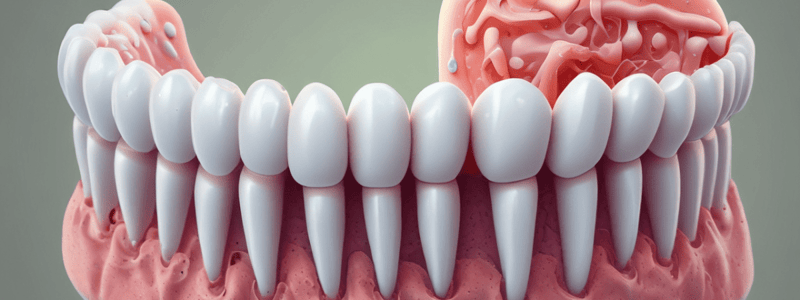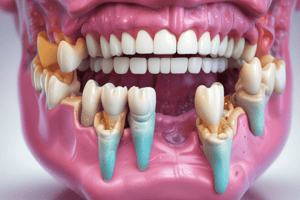Podcast
Questions and Answers
What is the primary function of glucosyl transferases in Streptococcus mutans?
What is the primary function of glucosyl transferases in Streptococcus mutans?
- Breakdown of lactate to produce energy
- Increasing the pH of the oral environment
- Enabling the bacteria to adhere to surfaces
- Producing glucan polymers from sucrose (correct)
What is the characteristic of Lactobacillus that differentiates it from other oral bacteria?
What is the characteristic of Lactobacillus that differentiates it from other oral bacteria?
- It is an acidogenic and aciduric bacterium
- It produces glucan polymers from sucrose
- It is a Gram-negative anaerobic cocci
- It can be found in other parts of the body and in fermented foods (correct)
What is the role of Veillonella in the development of dental caries?
What is the role of Veillonella in the development of dental caries?
- It colonizes existing lesions (correct)
- It produces acid from lactate
- It initiates the development of caries
- It competes with other bacteria for nutrients
What is the term for the ability of bacteria to survive and flourish in low pH conditions?
What is the term for the ability of bacteria to survive and flourish in low pH conditions?
What is the function of antigen I/II in Streptococcus mutans?
What is the function of antigen I/II in Streptococcus mutans?
What is the primary source of nutrients for bacteria in the oral mucosa?
What is the primary source of nutrients for bacteria in the oral mucosa?
What is the primary source of sugars that can be used by bacteria in the plaque?
What is the primary source of sugars that can be used by bacteria in the plaque?
What is the primary role of alpha-amylase in plaque and caries?
What is the primary role of alpha-amylase in plaque and caries?
What is the result of glycolysis?
What is the result of glycolysis?
What is the primary function of extracellular polysaccharides (EPS) in plaque?
What is the primary function of extracellular polysaccharides (EPS) in plaque?
Which enzyme is responsible for synthesising glucan?
Which enzyme is responsible for synthesising glucan?
What is the role of enolase in glycolysis?
What is the role of enolase in glycolysis?
What is the effect of fluoride on the glycolysis cycle?
What is the effect of fluoride on the glycolysis cycle?
Which stage of the plaque hypothesis involves the buffering capacity of saliva being lost?
Which stage of the plaque hypothesis involves the buffering capacity of saliva being lost?
What is the role of Scardovia wiggsiae in carious lesions?
What is the role of Scardovia wiggsiae in carious lesions?
What is the primary function of IPS in S.mutans?
What is the primary function of IPS in S.mutans?
Flashcards are hidden until you start studying
Study Notes
Dental Caries Development
- Four factors required for dental caries development: teeth, bacteria in plaque, fermentable carbohydrate in diet, and time.
Nutrient Sources for Oral Bacteria
- Three sources of nutrients for bacteria in the oral mucosa: saliva, gingival crevicular fluid, and host diet.
Main Bacteria in Caries
- Three main bacteria found in caries: Streptococcus mutans, Lactobacillus, and Veillonella.
Acidogenic and Aciduric Bacteria
- Acidogenic bacteria produce high levels of acid.
- Aciduric bacteria can survive and flourish in low pH conditions.
- Streptococcus mutans is both acidogenic and aciduric, allowing it to thrive in low pH environments.
Streptococcus mutans Virulence Factors
- Three virulence factors for Streptococcus mutans: Antigen I/II (enables adherence to surfaces), glucosyl transferases (produces glucan polymers from sucrose), and glucan binding proteins (enables bacteria with glucan to bind to oral mucosa).
Lactobacillus Characteristics
- Lactobacillus can be found in other parts of the body and fermented foods.
- Lactobacillus is an opportunist organism that requires a low pH habitat and colonizes existing lesions.
Veillonella Characteristics
- Veillonella is a Gram-negative anaerobic coccus.
- Veillonella grows using lactate as a substrate for growth and thrives in carious lesions where lactate is present.
Plaque Hypothesis Stages
- Three stages in the plaque hypothesis: dynamic stability, acidogenic, and aciduric.
- Dynamic stability stage involves acid production from sugars, followed by an alkalisation phase.
- Acidogenic stage involves repeated sugar intake, poor oral hygiene, and reduced salivary flow, leading to acid production by non-mutans streptococci and Actinomyces.
- Aciduric stage involves the selection of aciduric bacteria, such as S. mutans, Lactobacillus, and some Bifidobacterium and Propionibacterium species, due to the loss of buffering capacity and change in the microbiota.
Saliva's Role in Plaque and Caries
- Amylase is a critical component of saliva in plaque and caries.
- Alpha-amylase hydrolyses starch to glucose and maltose, making them available for fermentation, and binds with high affinity to oral streptococci, facilitating glucose uptake.
Sugar Sources and Transport
- Sugars can be derived from the host diet and salivary components.
- Sugars are transported to the interior of cells via the phosphotransferase system (PTS) for glycolysis.
Glycolysis and Extracellular Polysaccharides
- Glycolysis results in pyruvate and 2 ATP molecules.
- Extracellular polysaccharides (EPS) are formed from bacterial metabolism of sucrose and become part of the plaque matrix.
Intracellular Polysaccharides and Glucosyl Transferases
- Intracellular polysaccharides (IPS) are formed by S. mutans and serve as storage molecules for later use.
- Three glucosyl transferases produced by S. mutans: GTFB and GTFC (form water-insoluble glucans), and GTFD (forms water-soluble glucans).
EPS Roles and Glucan Synthesis
- EPS is sticky and contributes to bacterial adherence to the pellicle and plaque.
- EPS makes bacteria more resistant to being washed away by food and drink.
- EPS serves as a source of sugars for metabolism when nutrients are limited.
- Glucan synthesis involves glucosyl transferase, sucrose, and glucan primer.
- Glucan is hydrolysed by glucanase.
Fructan Synthesis and Hydrolysis
- Fructan synthesis involves fructosyl transferase, sucrose, and fructan primer.
- Fructan is hydrolysed by fructanase.
Enolase and Fluoride's Effect on Glycolysis
- Enolase is a key regulatory enzyme in glycolysis.
- Fluoride inhibits enolase, reducing sugar transport and acid production.
Xylitol and Probiotics
- Xylitol is used to replace sugar and inhibits S. mutans growth in vitro.
- Xylitol is transported into S. mutans cells, but enters a futile cycle of phosphorylation, dephosphorylation, and export, using energy without producing ATP.
- Xylitol inhibits glycosyl transferase and is used to replace sucrose.
- Probiotics inhibit disease-associated oral bacteria.
Studying That Suits You
Use AI to generate personalized quizzes and flashcards to suit your learning preferences.



